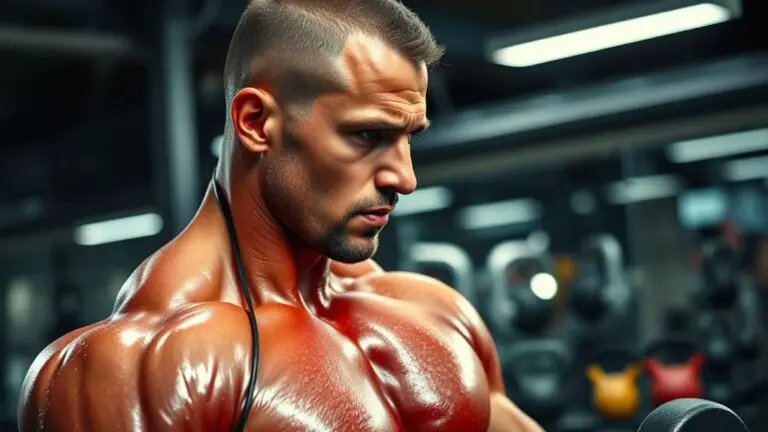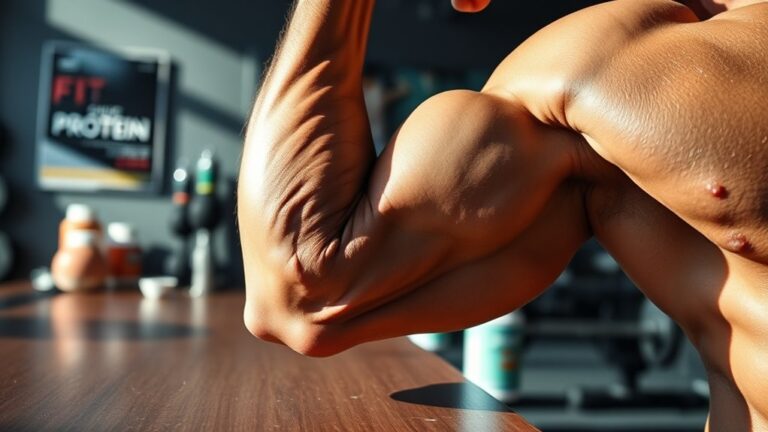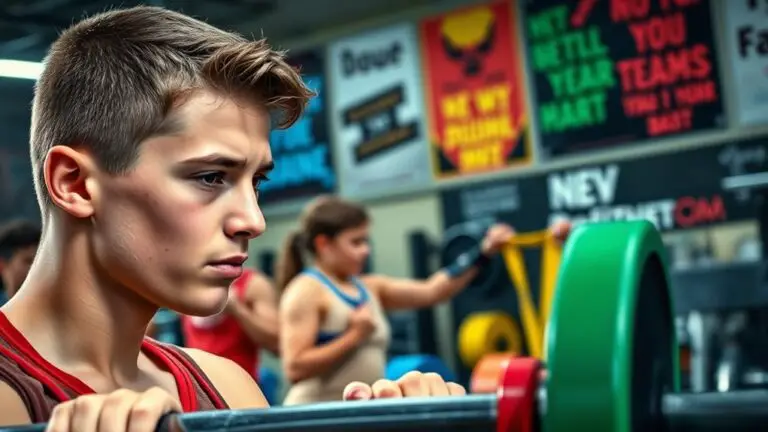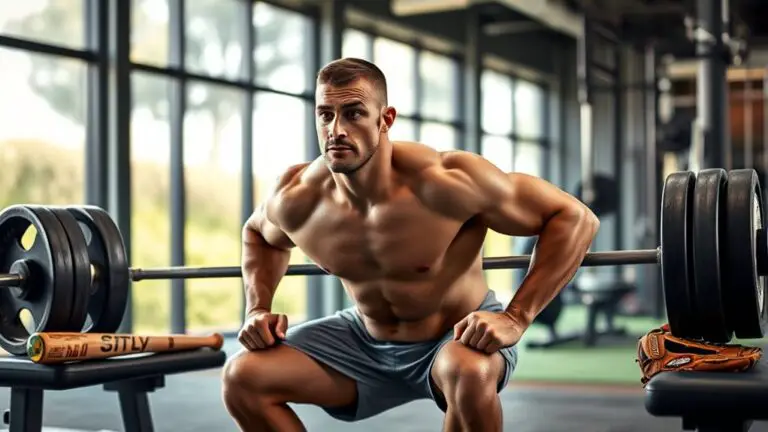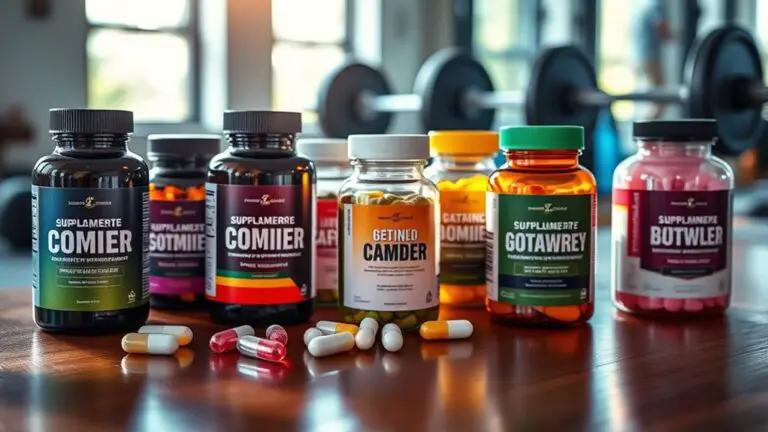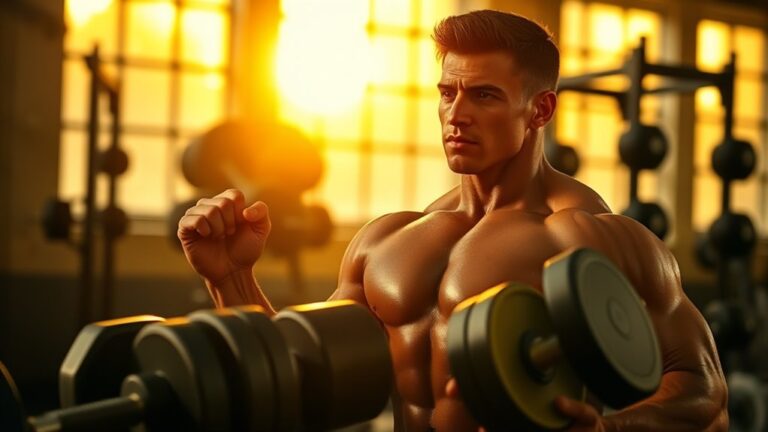The Best Gym Workouts for Teens Who Want to Build Muscle
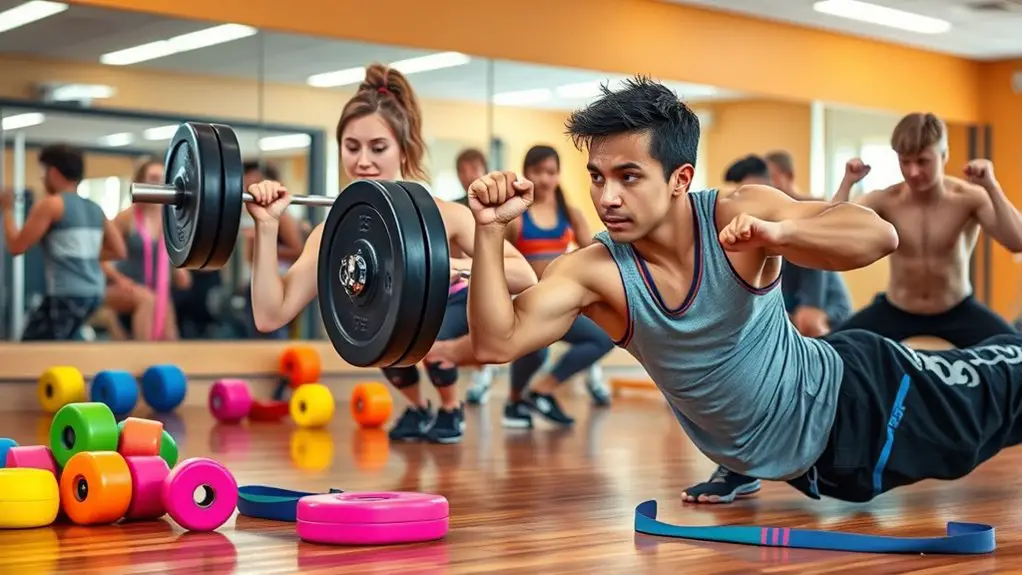
To build muscle as a teen, focus on full-body workouts that engage multiple muscle groups, using exercises like squats, push-ups, and lunges. Incorporate essential gym equipment like dumbbells and resistance bands to enhance your routine. Always prioritize proper form to prevent injuries and maximize results. Don’t forget the importance of nutrition, staying hydrated, and including cardio for overall fitness. If you’re ready to set realistic goals and track your progress, there’s more to discover.
Understanding Muscle Growth and Development
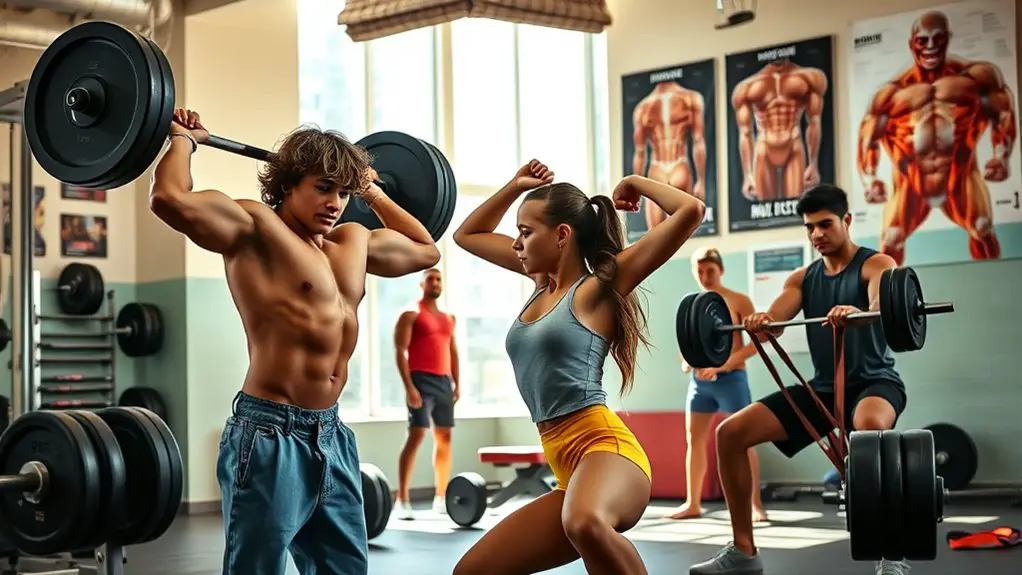
Muscle growth and development are key components of any effective workout routine, especially for teens enthusiastic to enhance their physical fitness. Understanding muscle hypertrophy is essential; it’s the process where your muscle fibers increase in size due to progressive overload during workouts. To achieve this, you’ll need to challenge your muscles with resistance training, gradually increasing weights or intensity over time.
Essential Gym Equipment for Teens
To effectively build muscle and achieve fitness goals, having the right gym equipment is just as important as understanding how your body works. Investing in essential tools can make a significant difference in your workout routine. Here’s what you should consider:
- Dumbbells: Perfect for a variety of dumbbell exercises, they help in building strength and muscle mass.
- Resistance Bands: These versatile bands provide variable resistance, making them great for both strength training and flexibility.
- Exercise Mat: A good mat is essential for comfort during floor exercises, ensuring safety and stability.
- Weight Bench: Ideal for performing various exercises, a bench will help you target different muscle groups effectively.
Equipping yourself with these items not only enhances your workout experience but also keeps you motivated. Remember, the right gear can lead to better results and a more enjoyable fitness journey! Additionally, understanding daily caloric intake can further optimize your muscle-building efforts.
Full-Body Workouts for Beginners
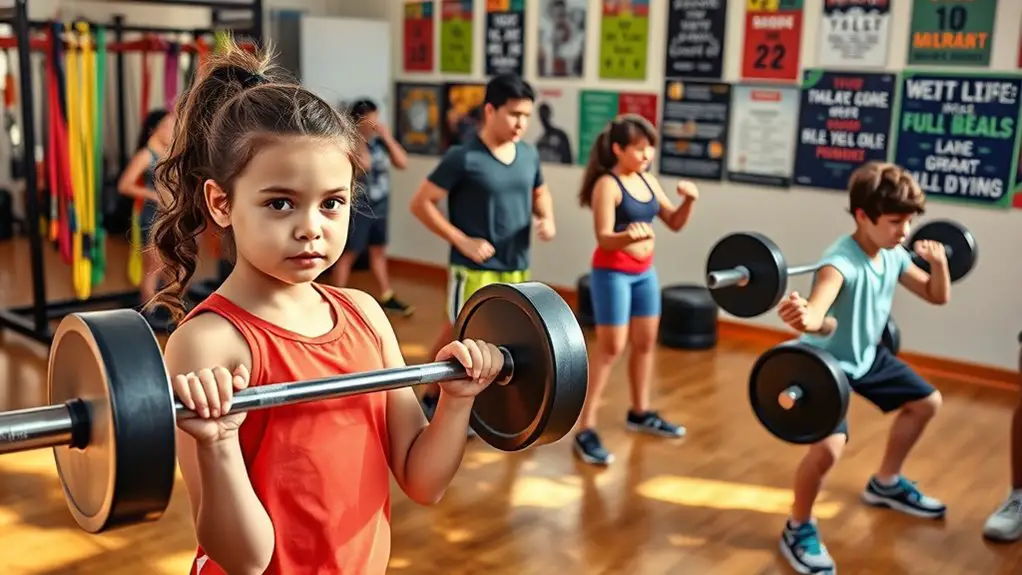
If you’re just starting your fitness journey, full-body workouts can be a game-changer. These workouts engage multiple muscle groups, making them efficient for building strength and endurance. Incorporating bodyweight exercises like push-ups, squats, and lunges can be a great way to kick things off without needing any equipment. Aim for a workout frequency of three to four times a week to see consistent progress.
Start with two or three sets of 8-12 reps for each exercise, and gradually increase the intensity as you get stronger. Remember, consistency is key, so stick to your schedule and track your progress. Don’t be discouraged by initial challenges; every rep counts towards your goals. Listening to your body is crucial during this process, as it helps prevent injury and supports long-term success. Full-body workouts not only improve your muscle tone but also boost your confidence and overall fitness. Embrace the journey, and soon you’ll notice the positive changes in your body and mindset!
Targeted Exercises for Major Muscle Groups
When it comes to building a strong foundation, targeting specific muscle groups is key. You’ll want to focus on upper body strength training, lower body power moves, and core stability exercises to maximize your results. Let’s explore how these targeted workouts can elevate your fitness game!
Upper Body Strength Training
While building upper body strength might seem intimidating at first, it’s an essential part of any teen’s fitness journey. Focusing on major muscle groups can help you gain confidence and improve your performance. Here are some effective exercises to incorporate into your routine:
- Push Up Variations: Try incline, decline, or diamond push-ups to target different muscle areas.
- Resistance Band Exercises: Use bands for rows, chest presses, and overhead lifts to enhance strength and stability.
- Dumbbell Shoulder Press: This builds shoulder strength and can be adjusted as you progress.
- Tricep Dips: Great for developing arm strength, you can do these on a bench or sturdy chair.
Stay consistent, and you’ll see progress in no time!
Lower Body Power Moves
Lower body power moves are essential for building strength and enhancing athletic performance, especially for teens who want to excel in sports or physical activities. Incorporating squat variations, like front squats or sumo squats, helps target different muscle groups and improve your overall leg strength. These variations not only build muscle but also enhance your stability and mobility.
Deadlift techniques, such as conventional and Romanian deadlifts, are also vital. They engage your hamstrings, glutes, and lower back, promoting functional strength that translates into better athletic performance. Aim for proper form to prevent injury and maximize gains. By mastering these exercises, you’ll develop a solid foundation for your lower body, setting you up for success in any sport or activity you pursue.
Core Stability Exercises
Core stability exercises are essential for developing a strong foundation for your overall fitness. They not only enhance your balance and posture but also prevent injuries during workouts. Here are four effective exercises you can try:
- Plank Variations: Mix it up with side planks or plank jacks to target different muscle groups.
- Stability Balls: Use these for exercises like ball passes or stability ball rollouts to engage your core and improve coordination.
- Dead Bugs: This exercise helps stabilize your core while enhancing coordination.
- Bird Dogs: Great for improving balance and core strength, focus on keeping your hips level.
Incorporating these movements into your routine will help you build a stronger, more stable core, setting you up for success in your muscle-building journey!
Importance of Proper Form and Technique
When you’re hitting the gym, mastering proper form and technique isn’t just about looking good; it’s essential for preventing injuries and maximizing your results. By focusing on how you lift and move, you’ll engage your muscles more effectively, paving the way for long-term progress. Remember, every rep counts, so let’s make sure you’re doing it right!
Injury Prevention Strategies
Although it might seem tempting to lift heavier weights or push through challenging exercises, maintaining proper form and technique is essential for preventing injuries, especially for teens just starting their fitness journey. Poor form can lead to various injury types, hindering your progress and enjoyment. Here are some key strategies to keep you safe:
- Warm-Up: Always start with a proper warm-up to prepare your muscles.
- Focus on Form: Prioritize technique over weight; it’s better to lift lighter with correct form.
- Listen to Your Body: If something doesn’t feel right, stop and assess.
- Rest and Recover: Incorporate recovery techniques like stretching or foam rolling to prevent injuries.
Effective Muscle Engagement
Proper form and technique not only help prevent injuries but also maximize muscle engagement during your workouts. When you focus on effective muscle engagement techniques, you’re ensuring that the right muscles are activated, leading to better results. For instance, during exercises like squats or deadlifts, maintaining proper alignment keeps your core engaged and optimizes workout intensity. Remember, it’s not just about lifting heavier weights; it’s about lifting correctly. Slow down your movements and pay attention to your body’s mechanics. This intentional approach can greatly enhance your strength gains and muscle development. So, embrace the learning curve, and don’t rush through your workouts. Mastering your technique now lays a solid foundation for your fitness journey ahead.
Long-term Progress Tracking
Tracking your progress over time is crucial for understanding how far you’ve come and where you need to improve, especially when it comes to maintaining proper form and technique. Using progress journals can help you stay accountable and focused on your goals. Here are some important workout metrics to monitor:
- Reps and Sets: Keep track of how many you do for each exercise.
- Weight Lifted: Note the weights you’re using to guarantee progression.
- Form Check: Regularly assess your technique to prevent injuries.
- Workout Frequency: Record how often you train to maintain consistency.
Creating a Balanced Workout Routine
Creating a balanced workout routine is essential for teens, especially when you’re aiming to build strength, improve endurance, and enhance overall fitness. Start by incorporating workout variety into your routine. Mix strength training, flexibility exercises, and functional movements to target different muscle groups and prevent boredom. For instance, combine weightlifting with bodyweight exercises and yoga sessions.
Equally important are recovery days. These give your muscles time to heal and grow, which is vital for building muscle. Aim for at least one or two rest days each week, allowing yourself to engage in light activities like walking or gentle stretching. Additionally, consider incorporating activities like skipping rope into your routine for a fun and effective full-body workout.
Incorporating Cardio for Overall Fitness

While strength training is essential for building muscle, incorporating cardio into your workouts can greatly enhance your overall fitness. Striking that fitness balance between strength and cardio will not only boost your endurance but also support your muscle gains. Here are some cardio benefits to take into account:
- Improved Heart Health: Cardio strengthens your heart, allowing it to pump blood more efficiently.
- Increased Endurance: It helps you push through those tough strength training sessions without feeling fatigued.
- Enhanced Recovery: Light cardio can aid in muscle recovery by increasing blood flow and reducing soreness.
- Weight Management: Combining strength training with cardio can help you maintain a healthy body composition. Additionally, skipping rope is an effective cardio workout that can help burn calories and enhance muscle tone.
Nutrition Tips to Support Muscle Gain
To build muscle effectively, you need to fuel your body with the right nutrition. Incorporating protein-rich foods, timing your meals wisely, and staying hydrated are all key components to support your gains. Let’s explore how these elements can make a significant difference in your fitness journey!
Protein-Rich Foods
When you’re hitting the gym and aiming to build muscle, incorporating protein-rich foods into your diet is crucial for fueling your progress. Proper meal planning guarantees you get the right protein sources to support your gains. Here are some great options to contemplate:
- Chicken Breast – Packed with lean protein, it’s perfect for muscle repair.
- Eggs – A versatile source of high-quality protein and healthy fats.
- Greek Yogurt – Offers both protein and probiotics for gut health.
- Lentils – A fantastic plant-based protein source that’s also high in fiber.
Including these foods in your meals not only helps you meet your protein needs but also energizes your workouts. Stay focused, eat smart, and watch your muscle growth accelerate!
Balanced Meal Timing
Eating protein-rich foods is just one piece of the puzzle for building muscle. To truly maximize your gains, you need to focus on balanced meal timing. Aim for consistent meal frequency throughout the day—eating every 3-4 hours can support muscle recovery and growth. Don’t skip meals or let too much time pass between them; your muscles need a steady supply of nutrients.
Incorporate healthy snacks between meals, especially post-workout, to refuel and stimulate muscle protein synthesis. Great options include Greek yogurt, nuts, or a protein shake. By paying attention to your meal and snack timing, you’ll provide your body with the energy it needs to thrive in the gym. Stay disciplined, and you’ll see the results of your hard work!
Hydration Importance
While you may focus on lifting weights and eating right, hydration is just as vital for muscle gain. Staying hydrated boosts your performance, helps recovery, and supports overall health. Here are some effective hydration strategies to improve your water intake:
- Drink Before, During, and After Workouts: This guarantees your muscles stay hydrated and ready to perform.
- Set Reminders: Use your phone or a water app to remind you to drink water throughout the day.
- Carry a Water Bottle: Keep it with you in school and at the gym to make hydration a habit.
- Flavor Your Water: If plain water isn’t appealing, try adding fruits or herbs for a rejuvenating twist.
Stay consistent, and your muscles will thank you!
Setting Realistic Goals and Tracking Progress
Setting realistic goals and tracking your progress is essential for a successful gym journey, especially for teens. Start with clear, achievable objectives—like increasing your bench press by five pounds or completing a set number of workouts per week. This kind of goal setting keeps you motivated and focused.
Once you’ve set your goals, regularly evaluate your progress. Keep a workout journal or use a fitness app to log your lifts, repetitions, and any physical changes. This not only helps you see how far you’ve come but also allows you to adjust your training plan if needed. Celebrate small victories along the way, like hitting a new personal best or sticking to your routine for a month. Remember, consistency is key! By setting realistic goals and tracking your progress, you’ll stay motivated and build the muscle you desire. Stay committed, and you’ll see the results!
Safety Tips for Young Lifters
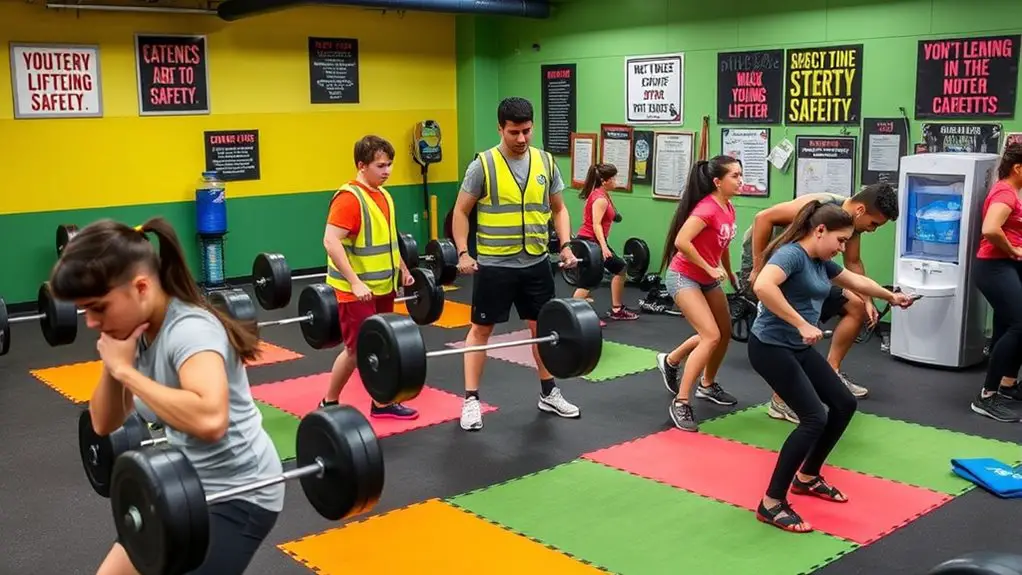
When you step into the gym, safety should be your top priority, especially as a young lifter. By following these essential tips, you can guarantee a safe and effective workout experience:
Safety is paramount in the gym, especially for young lifters; prioritize it for a successful workout experience.
- Lifting Supervision: Always have a knowledgeable adult or training partner present to guide you and provide assistance.
- Appropriate Weights: Start with lighter weights to master your form, gradually increasing as you gain strength and experience.
- Proper Warm-Up and Cool Down Routines: Always warm up before lifting to prep your muscles and cool down afterward to aid recovery.
- Mental Preparedness and Equipment Familiarity: Understand the equipment you’ll use and focus mentally on your workout to prevent accidents.
Remember to take your age into account when planning your training, and don’t hesitate to seek parental guidance for support. By implementing these strategies, you’ll build muscle while prioritizing your safety.
Frequently Asked Questions
How Often Should Teens Work Out to See Muscle Gains?
Like a sculptor chiseling away at marble, your workout frequency is key to revealing the masterpiece that is your body. To see muscle gains, aim for 3 to 5 workouts per week, balancing intensity and rest. Remember, muscle recovery is just as important; it’s during this time that growth happens. Listen to your body, adjust your routine as needed, and stay consistent. With dedication, you’ll transform your efforts into impressive results!
Can Teens Lift Heavy Weights Safely?
Yes, teens can lift heavy weights safely, but it’s essential to focus on proper lifting techniques. Start with lighter weights to master form, which helps prevent injuries. Always warm up and consider working with a coach or trainer to guarantee you’re using the correct technique. Remember, it’s not just about lifting heavy; it’s about building a strong foundation. Stay consistent, listen to your body, and you’ll see great progress over time!
What Supplements Are Safe for Teen Athletes?
When it comes to supplements for teen athletes, it’s essential to focus on safe options. Natural protein sources like lean meats, eggs, and dairy can help you build muscle effectively. Instead of relying on pills or powders, prioritize whole foods. Don’t forget hydration tips—drinking plenty of water before, during, and after workouts can enhance performance and recovery. Staying well-hydrated is just as vital as any supplement for your athletic success!
How Can Teens Stay Motivated to Work Out?
Staying motivated to work out can feel like climbing Mount Everest, but you can conquer it! Start by setting clear, achievable goals that excite you. Break them down into smaller milestones to celebrate your progress. Finding workout buddies can make a huge difference too; they’ll keep you accountable and make exercising way more fun. Surround yourself with positive influences, and remember, the journey is just as important as the destination! Keep pushing forward!
What Should Teens Do on Rest Days?
On rest days, you shouldn’t just kick back; instead, focus on active recovery. Light activities like walking, yoga, or swimming can help your muscles recover while keeping you engaged. Remember, rest benefits your body by allowing it to repair and grow stronger, which is essential for your fitness journey. So, embrace these days as a chance to rejuvenate and prepare for your next workout, rather than viewing them as downtime.
